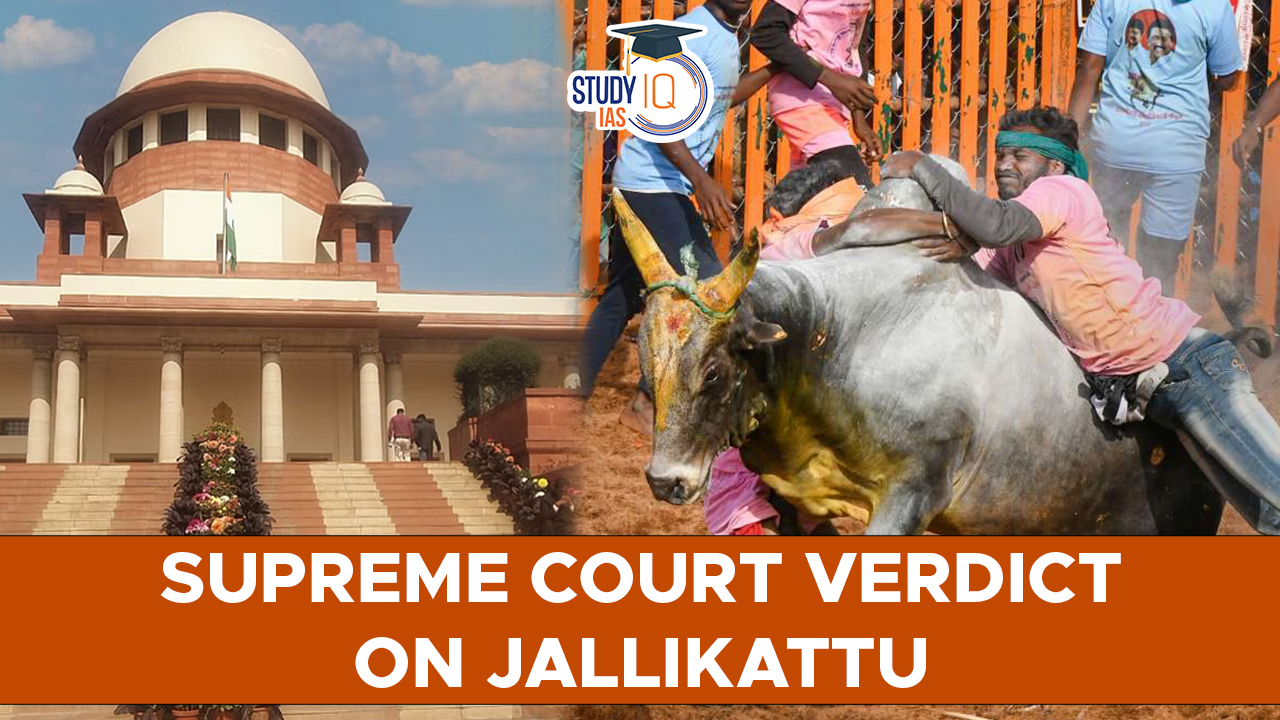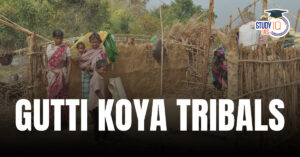Table of Contents
Context: A five-judge Constitution Bench of the Supreme Court has upheld the amendments made by Tamil Nadu, Maharashtra, and Karnataka to The Prevention of Cruelty to Animals (PCA) Act, 1960, allowing Jallikattu, Kambala, and bullock-cart races.
Key Highlights of the Judgment
- The court overturned the verdict of a two-judge Bench in ‘Welfare Board of India v. A. Nagaraja’ (2014), which had banned practices such as Jallikattu.
- The five-judge Bench noted that Jallikattu has been held in Tamil Nadu for at least a century, and “we will not disrupt the view of the Tamil Nadu legislature that it is part of the cultural heritage of the state”.
- The court upheld the validity of the ‘Prevention of Cruelty to Animals (Tamil Nadu Amendment) Act of 2017’, and ‘Prevention of Cruelty to Animals (Conduct of Jallikattu) Rules of 2017’, and said that the amendment laws “substantially minimizes” the pain and suffering of the animals participating in the event.
- The court also found similar laws passed by Karnataka and Maharashtra, allowing bullock cart races and buffalo racing ‘Kambala’, valid.
- However, the court directed that the district administrations and competent authorities in Tamil Nadu would be responsible to ensure that Jallikattu events are conducted in strict compliance of the safeguards laid out in the 2017 Amendment Act and Rules.
What is Jallikattu?
- Jallikattu is a traditional bull-taming sport that has been practiced in the state of Tamil Nadu for centuries.
- Jallikattu has been known to be practiced during the Tamil classical period (400-100 BCE).
- It is typically held during the Pongal harvest festival, which takes place in mid-January.
- The sport involves releasing a bull into an arena, and participants attempt to grab and hold onto the bull’s hump for a specific period of time or distance. It is considered a test of strength and skill for the participants.

The Story of Legal Battles over Jallikattu
- The story of the ban on Jallikattu begins with concerns about animal cruelty.
- Animal rights activists and organizations, including the Animal Welfare Board of India and People for the Ethical Treatment of Animals (PETA), raised objections to the sport, claiming that it caused unnecessary harm and suffering to the bulls involved.
- They argued that the bulls were subjected to physical abuse, such as beating, prodding, and twisting of their tails, and that the sport violated the provisions of the Prevention of Cruelty to Animals Act, 1960.
- Supreme Court’s 2014 verdict:
- A two-judge Bench of the Supreme Court of India, in the case of ‘Welfare Board of India vs A. Nagaraja,’ banned Jallikattu and similar practices.
- The Court ruled that the Prevention of Cruelty to Animals Act superseded the so-called cultural and traditional aspects of Jallikattu, emphasizing the importance of animal rights.
- Aftermath of the verdict:
- The ban on Jallikattu faced opposition from Tamil Nadu, where the practice is deeply rooted in the cultural heritage of the state.
- Protests and public demonstrations took place, with supporters of Jallikattu arguing that it was an essential part of their tradition, identity, and agrarian way of life.
- Amendment to the Prevention of Cruelty to Animals Act:
- In response to the widespread protests, the central government of India passed an amendment to the Prevention of Cruelty to Animals Act in 2017, allowing Jallikattu and similar practices under certain conditions.
- The amendment placed specific regulations and safeguards to protect the welfare of the bulls and ensure the humane conduct of the sport.
- And now, the Supreme Court has upheld the amendments to the Prevention of Cruelty to Animals Act and allowed the bull taming sport Jallikattu.
- Arguments of opponents over Jallikattu:
- Animal Cruelty: Opponents argue that Jallikattu subjects the bulls to unnecessary pain, suffering, and abuse.
- Violation of Animal Welfare Laws: Jallikattu is seen as a violation of the Prevention of Cruelty to Animals Act, 1960, which aims to protect animals from unnecessary harm and suffering
- Safety Concerns: Jallikattu poses significant safety risks to both participants and spectators. The unpredictable nature of bulls can lead to injuries and even fatalities.
- Alternative Cultural Expressions: Those against Jallikattu contend that cultural expressions should evolve over time and adapt to changing societal values.
- Arguments of proponents over Jallikattu:
- Cultural Heritage: Jallikattu is an integral part of Tamil Nadu’s cultural heritage and has been practiced for centuries.
- Economic Importance: Jallikattu is not just a sport but also an important economic activity. It promotes cattle breeding, encourages the improvement of native breeds, and contributes to the livelihoods of farmers and land-owning castes.
- Proper Regulations: Supporters argue that instead of banning Jallikattu outright, the focus should be on implementing and enforcing strict regulations to ensure the welfare of the animals involved.
The Landscape of Animal Welfare in India
Constitutional Protection for animal Rights
- Article 48 A states that the state shall endeavor to protect and improve the environment and safeguard the country’s forests and wildlife.
- Article 51 A (g) states that every citizen has a fundamental duty to safeguard and improve the natural environment including forests, lakes, rivers, and animals as well as to have compassion for living creatures.
- The above Constitutional provisions were introduced by the 42nd amendment in 1976.
- These provisions are not directly enforceable by courts but provide a base for legislation, policies, and laws in further animal protection at the central and state levels.
- The concurrent list (Seventh Schedule) of the Indian Constitution gives power to central and state to make laws on:
- Prevention of cruelty to animals,
- Protection of wild animals and birds.
The Rights of Animals in India
- Right to Life:
- According to Article 21, everyone has the right to life and personal liberty and cannot be deprived of either, unless established by law.
- The Supreme Court in the case of Animal Welfare Board of India v. Nagaraja (2014), specifically ruled on Article 21 in favour of animals.
- Right of compassion and preservation:
- The Supreme Court of India held in State of Gujarat v. Mirzapur Moti Kureshi Kassab Jamat (2005) that the Parliament enacted Article 51A in order to be read with Articles 48 and 48A, thereby ensuring that all provisions are read with the spirit of the law.
- No animal shall be slaughtered:
- According to Rule 3 of Prevention of Cruelty to Animals, (Slaughterhouse) Rules, 2001 it is illegal to slaughter any animal (including chickens) anywhere other than a slaughterhouse.
- Animals that are sick or pregnant must not be slaughtered.
Important Laws in India for the Protection of Animals
- The Prevention of Cruelty Act, 1960:
- The Act’s objective is to prevent the infliction of pain or suffering on animals and amend the laws related to the prevention of cruelty to animals.
- The word ‘animal’ is defined as ‘any living creature other than a human being’.
- The Act prescribes for the establishment of the Animal Welfare Board of India (AWBI) to protect animals from being subjected to unnecessary pain. The AWBI performs the following functions:
- To advise the central government regarding amendments and rules to prevent unnecessary pain while storing animals for experiments, transporting animals, etc.
- To encourage financial assistance, animal shelters, and rescue homes for old animals.
- To advise the government on medical care and assistance for animal hospitals.
- Imparting education and awareness on animal welfare using books, lectures, posters, advertisements.
- To advise the central government regarding the general matters on animal welfare.
- The Wildlife Protection Act,1972:
- The Act prohibits the killing, trapping, poaching, poisoning, or harming of any wild animal or bird.
- The definition of wildlife under the Act includes any animal, aquatic, or land vegetation that forms part of any habitat.
- This Act is the first legislation that provides a broad list of endangered wildlife species.
- It also provides the establishment of wildlife advisory boards for the protection of wildlife in every state to tackle the situation.
- The provisions for the protection of aquatic life (marine animals), birds, and zoo animals are also covered under the Act.
- The Act allows the Center and State governments to declare any area ‘restricted’ for the wildlife sanctuary, National park, etc.


 Global Labour Shortage and Opportunities...
Global Labour Shortage and Opportunities...
 Gutti Koya Tribals in Post-Conflict Indi...
Gutti Koya Tribals in Post-Conflict Indi...
 Civil Services Day 2025, Date, History, ...
Civil Services Day 2025, Date, History, ...





















